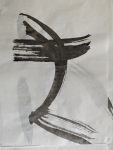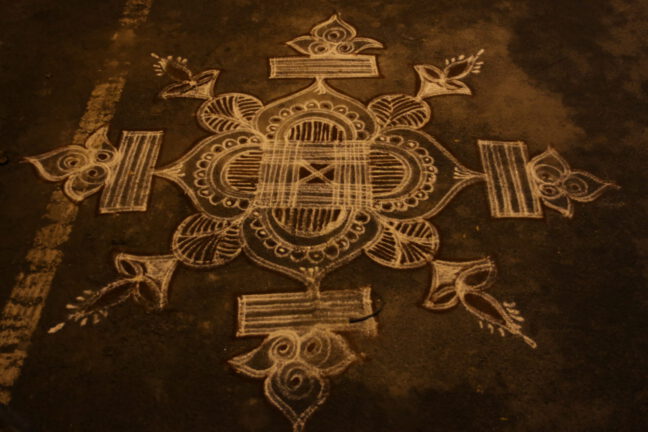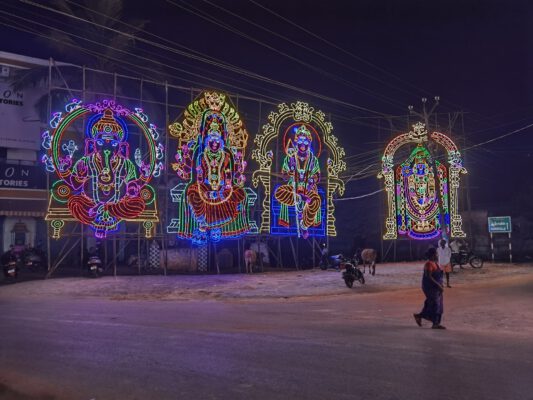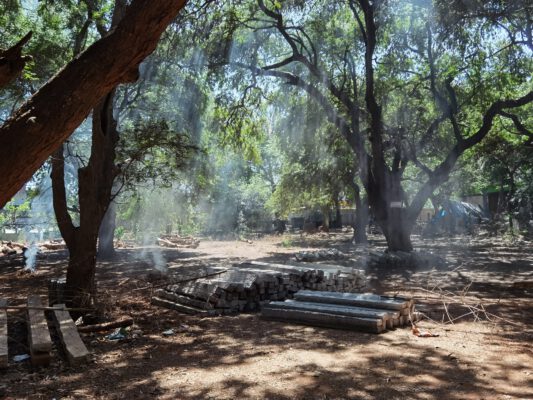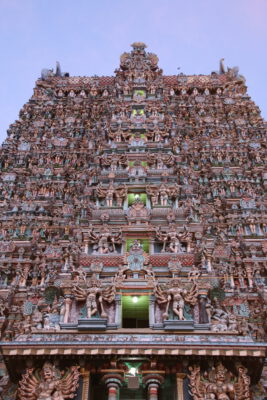Dhe secret of the Kolams
In the morning, before sunrise, when most of the animals are still asleep and the rooster has not yet crowed and when the men go to the temples, the women draw kolams on the street in front of the house. In Tamil Nadu, kolams have been drawn for centuries, if not millennia. This form of meditation, art, prayer, honoring the gods and blessing is usually practiced by women.
In the tradition, many families have had their own kolams for generations, as there are an infinite number. Some are 'classics' and are drawn in front of the house, on the street or in the temple on holidays, for example. Others are very individual and serve as a morning routine. A kolam is drawn at every festival in the south of India. The large kolams are difficult and take years of practice.
I have often seen the women in the villages of Kolam drawing early in the morning before sunrise. They sweep the street and prepare the ground. They use rice flour, which is sprinkled on the ground with their hands. This rice flour is a gift and is eaten by the insects, the kolams in front of the house are crossed and traversed during the day, and at the end of the day they are gone again. So that a new one can be drawn the next morning.
The basic principle of most kolams is the connection of points in a regular grid in such a way that the lines or curves do not cross without a certain symmetry, i.e. points are usually not simply connected crosswise. Many say that it is a language. The patterns are complex and include elements of symmetry, nets, algorithms, iterations, etc.
Kolams are complex
There are a whole series of levels on which Kolams work:
Drawing kolams is a movement of the whole body and has elements of dance, meditation and contemplation. The posture, the scattering of rice flour, the coordination of arm, leg, breathing, eye, fingers, spine and balance requires whole-body coordination. It is a practice that requires practice and is part of a long tradition. The complexity of the kolams, the quality of execution and the regularity are perceived in a community and suggest conclusions about the performer.
Individual geometric patterns are assigned to gods, legends, seasons, crops, stars etc.... The combination of different patterns in a kolam therefore contains a statement, they store knowledge that is passed on over generations, i.e. centuries and millennia. In the sense of a semiotic analysis, kolams can therefore be decoded.
The geometry of kolams can become extremely complex, overlapping with yantras, mandalas and tantras. However, kolams are often seen as purely decorative, ritualistic and traditional. Yantras, mandalas and tantras, on the other hand, are presented as part of the highest spiritual practice. In recent decades, much research has been done to appreciate the complexity of kolams and to correct this misconception.
So some speak of the language of the Kolams. Grace, an Aurovillian who grew up in the Sri Aurobindo Ashram, recently said that she speaks Kolams better than Tamil. She sees wisdom, history, spirituality, body control, science, social function etc. in the Kolams.
Kolams are complex signs that provide access to a world. The world that they open up is captured holistically. The structure of this language encompasses an infinite number of symbols, it has its own grammar and syntax within each individual kolam, its rules are mathematical and its expression aesthetic. This language is anything but trivial, it has been forgotten and has been analyzed for several decades.
Computer animation
These Kolams make me think of John Whitney's catalog from 1961. Whitney was in IBM's research laboratory and had access to the best analog computers. He used this access to explore the artistic and aesthetic potential of computers. His Documentation from 1968 is still impressive today. He sees the computer as a tool for exploring the language of art, based on graphic patterns that rotate and shift like a kaleidoscope. Much of it looks like kolams.
And so the circle closes. In the middle of the 20th century, progress is looking ahead, materialistically influenced scientists are chasing a dream of explaining the universe with numbers. And in India, mathematical colams have been drawn on the streets for thousands of years in an attempt to establish a connection to creation. Both are about mathematical images, one coming from the gods, the other from the rational mind. In India, we know that the rational mind is limited and does not understand the essentials. The images here, for example in the Kolams, allow a cosmic foresight and circumspection that embraces the idea of progress in the West.
—
"Dr.Gift Siromoney's Home Page". n.d. Accessed April 20, 2023. https://www.cmi.ac.in/gift/Kolam.htm.
"KolamYoga with Grace - Www.Kolamyoga.Com". n.d. Accessed April 22, 2023. https://www.kolamyoga.com/.
"Significance of Kolam in Tamil Culture". n.d. Sahapedia. Accessed April 20, 2023. https://www.sahapedia.org/significance-of-kolam-tamil-culture.
"Yantra Kolam - Www.Kolamyoga.Com". 2021. July 3, 2021. https://www.kolamyoga.com/yantra-kolam/.
Chaki, Rohini. 400 A.D. "How an Ancient Indian Art Utilizes Mathematics, Mythology, and Rice". Atlas Obscura. 08:00 400 AD. http://www.atlasobscura.com/articles/indian-rice-art-kolam.
Grace Gitadelila, Reg. 2022. Kolam drawings animated by Grace Gitadelila & Sasikanth Somu. https://www.youtube.com/watch?v=sKCstot0II4.
lab, City Interaction. 2020 "Mathematics of Kolam: Folkloric Graph Theory". Medium (blog). November 29, 2020. https://liubauer.medium.com/mathematics-of-kolam-folkloric-graph-theory-4b3acc79d5cb.
Whitney, John, Reg. 1968. Experiments in Motion Graphics. IBM Corporation / IBM Direct / IBM K-12 Assist Group / IBM Publications 4800 Falls of the Neuse Rd Raleigh NC 27609 USA (800)879-2755. http://archive.org/details/experimentsinmotiongraphics.
"Yantra Kolam - Www.Kolamyoga.Com". 2021. July 3, 2021. https://www.kolamyoga.com/yantra-kolam/.
Majumdar, Meghna. 2020 "Exploring Centuries of Kolams". The Hindu, January 16, 2020, History & Culture section. https://www.thehindu.com/society/history-and-culture/exploring-centuries-of-indias-traditional-kolams/article30573492.ece.
YANAGISAWA, Kiwamu, and Shojiro Nagata. 2007. "Fundamental Study on Design System of Kolam Pattern", January.

